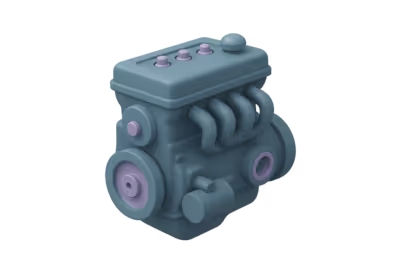Boilers
Boiler Efficiency
Where:
: Mass of steam generated. : Enthalpy of steam. : Enthalpy of feed water. : Mass of fuel. : Lower heating value of the fuel.
Thermal Efficiency of a Boiler
Combustion Ratio
Combustion Systems
Lower Heating Value (LHV)
Where:
: Energy released during combustion. : Mass of the fuel.
Combustion Efficiency
Stoichiometric Combustion Balance (for hydrocarbons)
Engine Cooling
Heat Transfer Ratio (in water-cooled engines)
Where:
: Mass of water circulating in the system. : Specific heat of water. : Temperature of water at the engine inlet. : Temperature of water at the engine outlet.
Thermal Balance of the Engine
Where:
: Heat generated by combustion. : Heat lost by dissipation. : Heat converted into useful work.
Carnot Cycle
Temperatures in the Carnot Cycle
The efficiency of the Carnot cycle depends on the temperatures of the hot and cold sources:
- Temperature of the hot source
- Temperature of the cold source
These temperatures must be expressed in kelvin (K).
Efficiency of the Carnot Cycle
The efficiency of the Carnot cycle is defined as the fraction of the absorbed heat that is converted into work. This efficiency depends only on the temperatures of the hot and cold sources:
Where:
= efficiency of the Carnot cycle (dimensionless, usually expressed as a percentage) = temperature of the hot source (in Kelvin) = temperature of the cold source (in Kelvin)
Heat Transferred in the Carnot Cycle
In a Carnot cycle, heat is absorbed and released during isothermal processes.
Heat absorbed from the hot source
Where:
= number of moles of gas = ideal gas constant = temperature of the hot source (in Kelvin) and = initial and final volumes of the gas during isothermal expansion.
Heat released to the cold source
Where:
= temperature of the cold source (in Kelvin) and = initial and final volumes during isothermal compression.
Work Done in the Carnot Cycle
The net work done by a Carnot cycle is the difference between the heat absorbed and the heat released:
It can also be expressed in terms of the temperatures and volumes:
Relationship Between Volume and Temperature in Adiabatic Processes
During adiabatic processes, there is no heat transfer. The relationship between volume and temperature in an adiabatic process for an ideal gas is given by:
Where
Relationship Between Work and Efficiency
The work done can also be related to the efficiency of the Carnot cycle:
Where:
= net work done by the cycle = heat absorbed from the hot source = efficiency of the Carnot cycle
Entropy in the Carnot Cycle
The total change in entropy in a Carnot cycle is zero, as it is a reversible cycle:
Change in entropy in the hot source
Change in entropy in the cold source
Since
Inverse Carnot Cycle (Refrigeration)
For an inverse Carnot cycle, used in refrigeration, the coefficient of performance (COP) is defined as:
COP for Refrigerator
COP for Heat Pump
Where:
= heat extracted from the cold source = heat delivered to the hot source = work done in the cycle

